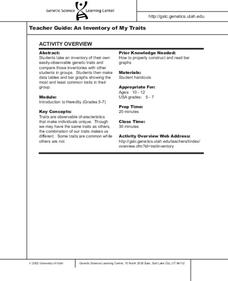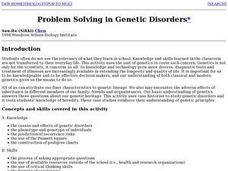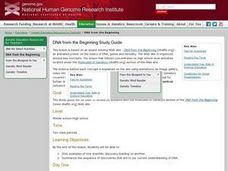Curated OER
Snappy Products
Young scholars explore genetics and biotechnology. Working in a group as a "biotech company", they genetically modify a plant and then promote their product at a biotechnology funding fair.
Curated OER
Bird Land
Students role-playing the concept of evolution through naturally occurring mutations. Working in pairs, they model how birds have adapted to the food sources in their environment through changes in their beak size and shapes. Students...
Curated OER
Survivors on the Ocean Ridge
High schoolers discover the uniqueness of deep sea hydrothermal vent organisms through an exploration of the NOAA Galapagos Rift Expedition. They study the genetics and evolution of a shrimp species that lives near the vents then they...
Curated OER
Genetically Modified Food
Students work in teams to develop a presentation and handout representing a particular point of view in a genetically modified food debate. They synthesize their knowledge of food, food contamination, nutrition, and their issues, and...
Curated OER
An Inventory of My Traits
Students take an inventory of their own easily-observable genetic traits and
compare those inventories with other students in groups. They then make
data tables and bar graphs showing the most and least common traits in their group.
Curated OER
Genetics 5 Technology
Learners, after studying extraction and gel electrophoresis, recombinant DNA, transgenic organisms, and reproductive cloning, summarize the main concepts in DNA technology. They analyze the applications of DNA: forensics, medicine,...
Curated OER
Mapping the Human Journey
Learners explore a migration of people with their surname. As a class, they define key vocabulary and identify the different types of movementbs of people in history. They examine the reasons for the migration and use the internet to...
Curated OER
Ethical Decision Making Model
Students consider the factors that relate to decisions regarding genetic disorders. They read case studies and complete a provided Bio-Ethical Decision-Making Worksheet.
Curated OER
Creating New Forms of Life
High schoolers are asked to use their imaginations to take the idea of biotechnology one step further. Before beginning this activity students read and complete a report on the book "Jurassic Park," which deals with the use of...
Curated OER
All in the Family
Students develop family genealogy charts in search of noticeable genetic relationships between relatives. They research their family and write a reflection on the genetic relationships between individuals on the chart.
Curated OER
Genetics of Parenthood
Students participate in an activity where they flip coins to determine which allele they pass on to the F1 generation and draw the resulting child's face. They identify several inheritance patterns including dominant, recessive,...
Curated OER
Problem Solving In Genetic Disorders
Students explore the causes and effects of genetic disorders. They examine the phenotype and genotype of individuals and predict the recurrenence risks. Students generate a Punnett square and construct pedigree charts.
Curated OER
Teaching About Inherited Human Disorders Through Case Studies
Students explore case studies involving human disorders. They identify options and consequences of each decision. Students interview a family member with a disorder. They create a presentation of their interview.
Curated OER
Outdoor Classroom's for the '90s Student
Students relish in experiencing an outdoor classroom. Students sign a contract stating that they will follow the rules of the outdoor classroom. Students help to keep the outdoor classroom clean and up to date with all the needed...
Curated OER
Island Biogeography and Evolution: Solving a Phylogenetic Puzzle With Molecular Genetics
Young scholars engage in solving a logic problem based on real organisms and real data. They develop phylogenies for seven related populations of lizards living on the Canary Islands.
Curated OER
Food's Altered Ego
Students write in their journals where they believe food comes from. After reading an article, they examine the proceses of cultivation and sale of genetically modified foods. Using the internet, they research specific countries and...
Curated OER
DNA-B-C's
Young scholars review what they already know about DNA. After reading an article, they discover a new technique to map the course of evolution. In groups, they create ways to present this material to younger children and research DNA's...
Curated OER
The ABC's of DNA
Students describe genetics as if they were explaining it to a young child. After reading an article, they discover new discoveries in the human genome project. Using the internet, they research a pair of genetic terms and develop a...
Curated OER
Translating Genetic Information
Students explore the process of translation. They determine the correct sequencing and present their strands to the class. In addition, they compare normal red blood cells to sickle cells and complete discussion questions.
Curated OER
TE Lesson: What's Dominant?
Students study the number of chromosomes in the body cells, sperm cells, and egg cells of humans. They define allele, and examine the difference between dominant and recessive alleles. They complete an activity with jelly beans that...
Curated OER
Genetic Mind Reader Review Game
Students review some important concepts and terms relevant to the Human Genome Project and genetic research. The game is played like a mind reading session between two teams.
Curated OER
DNA from the Beginning Study Guide
Students complete a study guide using a website which is an animated primer on DNA, genes, and heredity. The Web site is organized around key concepts. The web links and study guide are included.
Curated OER
Enhancing Students' Problem-Solving Abilities
Students analyze the results of a hypothetical cloning experiment using a restriction endonuclease map obtained from an on-line data source. They answer the question, "How can I tell if the DNA I have obtained from this hypothetical...
Curated OER
Hardy-Weinberg Equilibrium
High schoolers investigate how Hardy-Weinberg Equilibrium is established and what assumptions and conditions are necessary to reach Equilibrium. They model alleles using materials such as index cards, M & M's and goldfish.
























